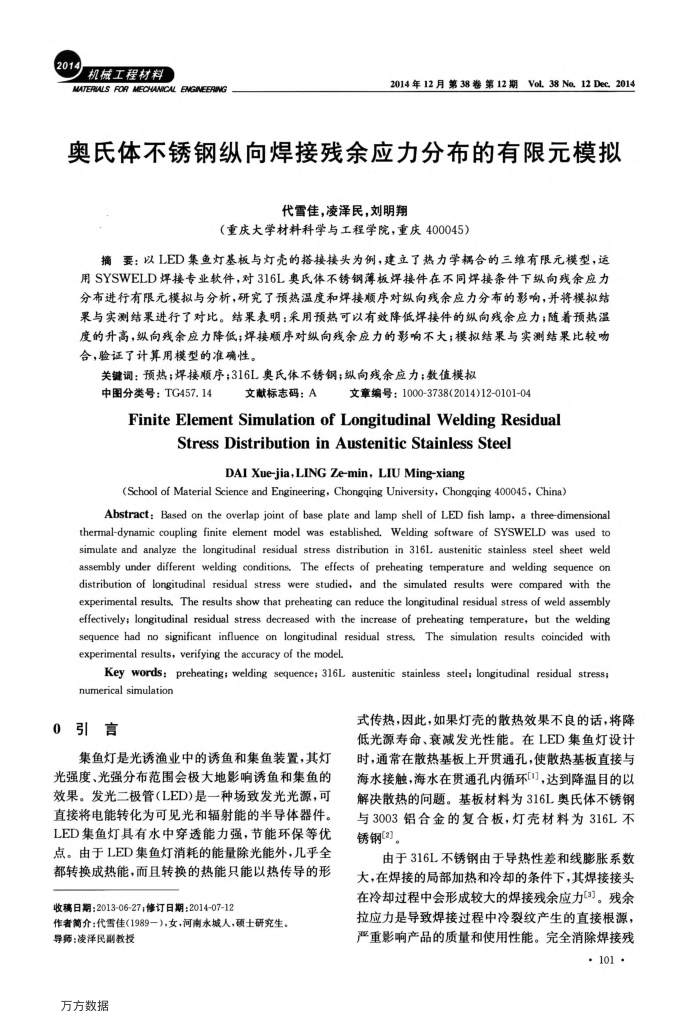奥氏体不锈钢纵向焊接残余应力分布的有限元模拟
内容简介
 20机械工程材料
20机械工程材料MATERSALSFORMECHANICALENGINEERING
2014年12月第38卷第12期Vol.38Na,12Dec.2014
奥氏体不锈钢纵向焊接残余应力分布的有限元模拟
代雪佳,凌泽民,刘明翔
(重庆大学材料科学与工程学院,重庆400045)
摘要:以LED集鱼灯基板与灯壳的搭接接头为例,建立了热力学耦合的三维有限元模型,运用SYSWELD焊接专业软件,对316L奥氏体不锈钢薄板接件在不同焊接条件下纵向残余应力分布进行有限元模拟与分析,研究了预热温度和焊接顺序对纵向残余应力分布的影响,并将模拟结果与实测结果进行了对比。结采表明:采用预热可以有效降低焊接件的纵向残余应力;随着预热温度的升高,纵向残余应力降低;焊接顺序对纵向残余应力的影响不大;模拟结果与实测结果比较吻合,验证了计算用模型的准确性。
关键调:预热;焊接顺序;316L奥氏体不锈钢;纵向残余应力;数值模拟
中图分类号:TG457.14
文献标志码:A
文章编号:1000-3738(2014)12-0101-04
FiniteElementSimulationofLongitudinal WeldingResidual
StressDistributioninAusteniticStainlessSteel
DAI Xue-jia,LING Ze-min, LIU Ming-xiang
(School of Material Science and Engineering, Chongqing University, Chongqing 400045, China)
Abstract: Based on the overlap joint of base plate and lamp shell of LED fish lamp, a three-dimensional thermal-dynamic coupling finite element model was established. Welding software of SYSWELD was used to simulate and analyze the longitudinal residual stress distribution in 316L austenitic stainless steel sheet weld assembly under different welding conditions, The effects of preheating temperature and welding sequence on distribution of longitudinal residual stress were studied, and the simulated results were compared with the experimental results. The results show that preheating can reduce the longitudinal residual stress of weld assembly effectively; longitudinal residual stress decreased with the increase of preheating temperature, but the welding sequence had no significant influence on longitudinal residual stress, The simulation results coincided with experimental results, verifying the accuracy of the model.
Key words: preheating; welding sequence; 316L austenitic stainless steel; longitudinal residual stress; numerical simulation
0引言
集鱼灯是光诱渔业中的诱鱼和集鱼装置,其灯光强度、光强分布范围会极大地影响诱鱼和集鱼的效果。发光二极管(LED)是一种场致发光光源,可直接将电能转化为可见光和辐射能的半导体器件。 LED集鱼灯具有水中穿透能力强,节能环保等优点。由于LED集鱼灯消耗的能量除光能外,几乎全都转换成热能,而且转换的热能只能以热传导的形
收稿日期:2013-06-27;修订日期:2014-07-12
作者简介:代雪佳(1989一),女,河南永城人,硕士研究生。
导师:凌泽民副教授万方数据
式传热,因此,如果灯壳的散热效果不良的话,将降低光源寿命、衰减发光性能。在LED集鱼灯设计时,通常在散热基板上开贯通孔,使散热基板直接与海水接触,海水在贯通孔内循环],达到降温目的以解决散热的问题。基板材料为316L奥氏体不锈钢与3003铝合金的复合板,灯壳材料为316L不锈钢[3]
由于316L不锈钢由于导热性差和线膨胀系数大,在焊接的局部加热和冷却的条件下,其焊接接头在冷却过程中会形成较大的焊接残余应力[3]。残余拉应力是导致焊接过程中冷裂纹产生的直接根源,严重影响产品的质量和使用性能。完全消除焊接残
· 101 ·
上一章:长输天然气管道焊接裂纹成因及控制措施研究
下一章:82BCr盘条焊后回火工艺